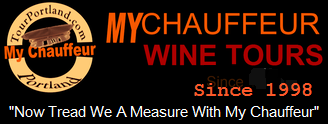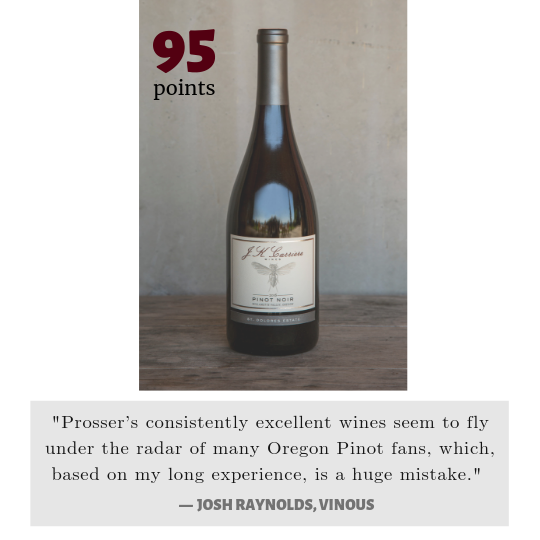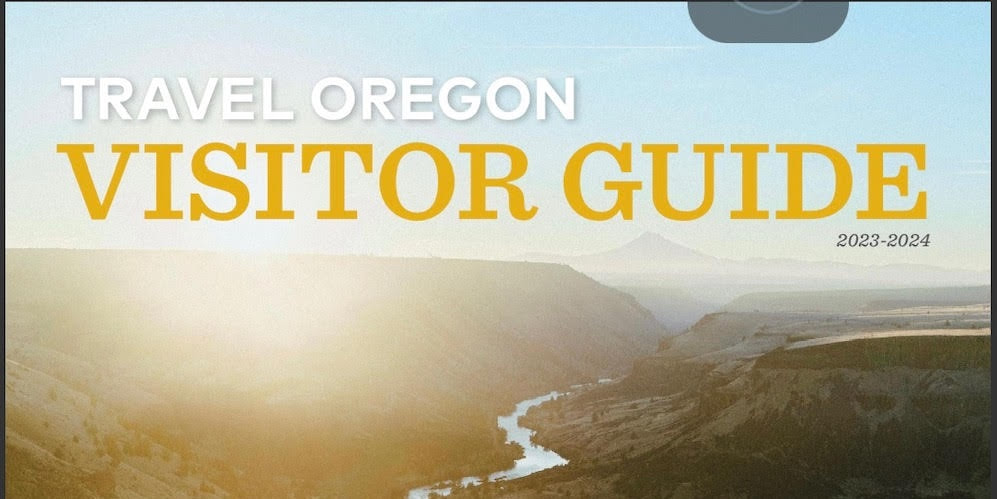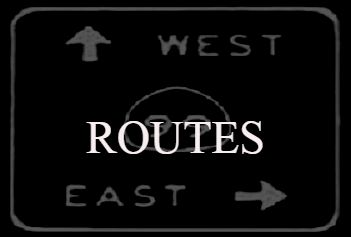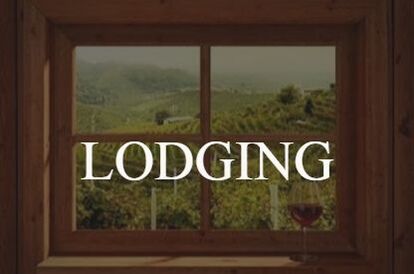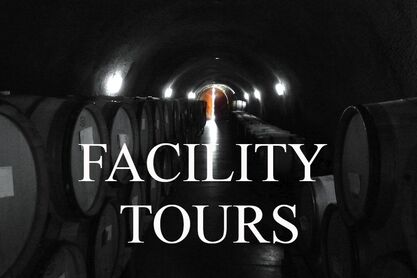J.K. Carriere's tasting room is open Friday and Saturday, 11 am to 4 pm, for drop-in visits (no appointment needed).
Call ahead with 4+ ppl. (requested by Linda). Bigger groups (10+?) can work if they can come before they open at 11am (say 10-10:30).
Private tasting appointments Monday through Thursday are available on a mutually agreeable basis.
$30 OR $50
J.K. Carriere
Call ahead with 4+ ppl. (requested by Linda). Bigger groups (10+?) can work if they can come before they open at 11am (say 10-10:30).
Private tasting appointments Monday through Thursday are available on a mutually agreeable basis.
$30 OR $50
J.K. Carriere
getting to know
St. Dolores Estate
Dolores: my mom’s name.
Saint or St.: an abbreviated prefix that, I suppose, sets an uncommon trajectory for a vineyard, one that is rooted, but not earthly bound.
Honestly, I bought these 40 acres, now named St. Dolores Estate, to see what a man could do. Not to run over nature, but to truly see it, vest it with my sinew and dreams, take in the nuance of everyday and just damn try for a few decades. I’ll be unlikely to coax from it all the answers, hell, not even all the questions, but I’m cognizant that the two most important things every morning are opening my eyes, and getting my boots on. It’s astonishing the amount of ground that gets plowed in the rearview, if one keeps head down moving forward. I’m following in the footsteps of my grandpa Paul Carriere, Mom’s Canadian wheat farmer dad, who was an astonishing man in just this way.
Now, if life is a combination of purpose and content, then there’s the purpose and this is the content. Labor Day 2007, I was buying a 1966 Ford flatbed from a neighbor up the road, when in conversation I became aware of “a piece of dirt” that a friend of his needed to move. I walked the grass and trees, I breathed it, I’d saved my pennies, so in less than a week we inked a deal for this “40 square”, crazy great, virgin dirt, south-facing flank of Parrett Mountain in the top of the Chehalem Mountains AVA. It was unmarred and beautiful.
Our hill overlooks the Cascade Mountain Range and presents as the top of a pretty sizeable baby’s head, spilling off in all directions. The vineyard is non-irrigated, organically farmed and sitting at an elevation of 700-500 ft. It’s comprised of eight variants of Jory soil (decayed volcanic, silty-clay loam) with reasonably shallow depths, then rolls to cobbled rock, and then to cracked basalt bedrock. That cobble keeps us busy picking rocks that grow up every winter, and those cracks offer root paths to stored water that the vines can exploit.
Yes, I became an owner, but more importantly, I’m a farmer. I’m not calling it in. Know that there is dirt on my Levis or a scythe in my hand, daily. Most of the vineyard is steep enough to roll a tractor, so we often use a crawler. We stand in front of each of these 38,000 hillside vines, something like thirteen times a year not just because it builds sexy calves, but rather, it makes the resultant wine better. It turns out the highest expression of wine grapes are like that, requiring both a great site (potential), and farming with intention (execution). Better, that’s the strongest way to tell a story in bottle.
We started prepping soil and building a winery here in 2008, stuck sticks in the ground, finished the winery and moved up in 2009, and it’s been a sleepless rocket ship ever since. We purposefully ate humble pie the first few years, declassifying the estate fruit to the blends, amping the intensity, opening up the canopy, dialing back the structure to ensure the emperor would be wearing his clothes in your glass. Even at that it surprised us, proved its promise, when in 2014 it stood toe-to-toe with the iconic established vineyards of Shea and Anderson Family, so we introduced it as St. Dolores Estate. The next year it surpassed everything, and it’s not looking back. We now farm 25 acres of vineyard rows at a density of 1660 vines per acre, with five clones of Pinot noir and four clones of Chardonnay on site. St. Dolores Estate is proving what we thought possible, and so you’ll continue to see movement towards a primarily estate-based winery, with a couple pieces of outside magic retained. That’s always been the plan, even when, cosmically, there was no plan at all.
All of this leads to the reason you’re still reading this: The wine from this place, that growing year and these hands is known as our “St. Dolores Estate,” a single-vineyard Limited bottling. The wine from our St. Dolores vineyard has a duality about it, a “typicity” as they say in French, yielding wines that are both structured AND juicy. The red fruit ripens slowly with moderately high acid and substantial structure. Just five or six best barrels are combined and bottled (about 150 cs) to make this highest expression from our estate vineyard. It’s a massive dark fruit attack with hints of fresh currant, rose petal, crimson spice, passion fruit and crème brulée. Exhibiting lovely movement on the palate, it’s luscious, balanced, long and persistent. Oh, and occasionally, somebody (perhaps a respected-in-the-trade critic), comes along and gives it a number that makes it fly.
— Jim Prosser
Owner/winemaker
St. Dolores Estate
Dolores: my mom’s name.
Saint or St.: an abbreviated prefix that, I suppose, sets an uncommon trajectory for a vineyard, one that is rooted, but not earthly bound.
Honestly, I bought these 40 acres, now named St. Dolores Estate, to see what a man could do. Not to run over nature, but to truly see it, vest it with my sinew and dreams, take in the nuance of everyday and just damn try for a few decades. I’ll be unlikely to coax from it all the answers, hell, not even all the questions, but I’m cognizant that the two most important things every morning are opening my eyes, and getting my boots on. It’s astonishing the amount of ground that gets plowed in the rearview, if one keeps head down moving forward. I’m following in the footsteps of my grandpa Paul Carriere, Mom’s Canadian wheat farmer dad, who was an astonishing man in just this way.
Now, if life is a combination of purpose and content, then there’s the purpose and this is the content. Labor Day 2007, I was buying a 1966 Ford flatbed from a neighbor up the road, when in conversation I became aware of “a piece of dirt” that a friend of his needed to move. I walked the grass and trees, I breathed it, I’d saved my pennies, so in less than a week we inked a deal for this “40 square”, crazy great, virgin dirt, south-facing flank of Parrett Mountain in the top of the Chehalem Mountains AVA. It was unmarred and beautiful.
Our hill overlooks the Cascade Mountain Range and presents as the top of a pretty sizeable baby’s head, spilling off in all directions. The vineyard is non-irrigated, organically farmed and sitting at an elevation of 700-500 ft. It’s comprised of eight variants of Jory soil (decayed volcanic, silty-clay loam) with reasonably shallow depths, then rolls to cobbled rock, and then to cracked basalt bedrock. That cobble keeps us busy picking rocks that grow up every winter, and those cracks offer root paths to stored water that the vines can exploit.
Yes, I became an owner, but more importantly, I’m a farmer. I’m not calling it in. Know that there is dirt on my Levis or a scythe in my hand, daily. Most of the vineyard is steep enough to roll a tractor, so we often use a crawler. We stand in front of each of these 38,000 hillside vines, something like thirteen times a year not just because it builds sexy calves, but rather, it makes the resultant wine better. It turns out the highest expression of wine grapes are like that, requiring both a great site (potential), and farming with intention (execution). Better, that’s the strongest way to tell a story in bottle.
We started prepping soil and building a winery here in 2008, stuck sticks in the ground, finished the winery and moved up in 2009, and it’s been a sleepless rocket ship ever since. We purposefully ate humble pie the first few years, declassifying the estate fruit to the blends, amping the intensity, opening up the canopy, dialing back the structure to ensure the emperor would be wearing his clothes in your glass. Even at that it surprised us, proved its promise, when in 2014 it stood toe-to-toe with the iconic established vineyards of Shea and Anderson Family, so we introduced it as St. Dolores Estate. The next year it surpassed everything, and it’s not looking back. We now farm 25 acres of vineyard rows at a density of 1660 vines per acre, with five clones of Pinot noir and four clones of Chardonnay on site. St. Dolores Estate is proving what we thought possible, and so you’ll continue to see movement towards a primarily estate-based winery, with a couple pieces of outside magic retained. That’s always been the plan, even when, cosmically, there was no plan at all.
All of this leads to the reason you’re still reading this: The wine from this place, that growing year and these hands is known as our “St. Dolores Estate,” a single-vineyard Limited bottling. The wine from our St. Dolores vineyard has a duality about it, a “typicity” as they say in French, yielding wines that are both structured AND juicy. The red fruit ripens slowly with moderately high acid and substantial structure. Just five or six best barrels are combined and bottled (about 150 cs) to make this highest expression from our estate vineyard. It’s a massive dark fruit attack with hints of fresh currant, rose petal, crimson spice, passion fruit and crème brulée. Exhibiting lovely movement on the palate, it’s luscious, balanced, long and persistent. Oh, and occasionally, somebody (perhaps a respected-in-the-trade critic), comes along and gives it a number that makes it fly.
— Jim Prosser
Owner/winemaker
|
2016 St. Dolores Estate Willamette Valley Pinot Noir
Review from Vinous: Vivid magenta color. A highly complex, expansive bouquet evokes fresh boysenberry, raspberry and Asian spices. A suave floral nuance builds with aeration. Sweet and seamless in the mouth, displaying impressive heft and clarity to its intense, mineral-accented red/blue fruit, lavender pastille and spicecake flavors. Shows outstanding energy and floral thrust on a gently tannic, penetrating finish that hangs on with superb, red fruit-driven tenacity. 95 points Single-bottle $65 (club $57, trade $45.50) |
Also available
2016 Antoinette WV Pinot Noir, $65 (club $57), 94 pts Vinous
2016 Gemini Vineyard WV Pinot Noir, $65 (club $57), 93 pts Vinous
2016 Vespidae WV Pinot Noir, $42 (club $36), 92 pts Vinous
2015 Lucidité Chardonnay, $32 (club $28)
2011 Blanc de Noir WV Sparkling, $80 (club $65)
2012 Vespidae WV Pinot Noir, $65 (club $55)
2012 Gemini Vineyard WV Pinot Noir, $90 (club $80)
2012 Cuvée Lola WV Pinot Noir, $110 (club $95)
2017 Provocateur WV Pinot Noir, $26 (club $22)
2018 Glass WV White Pinot, $24 (club $20)
Join the wine club!
2016 Antoinette WV Pinot Noir, $65 (club $57), 94 pts Vinous
2016 Gemini Vineyard WV Pinot Noir, $65 (club $57), 93 pts Vinous
2016 Vespidae WV Pinot Noir, $42 (club $36), 92 pts Vinous
2015 Lucidité Chardonnay, $32 (club $28)
2011 Blanc de Noir WV Sparkling, $80 (club $65)
2012 Vespidae WV Pinot Noir, $65 (club $55)
2012 Gemini Vineyard WV Pinot Noir, $90 (club $80)
2012 Cuvée Lola WV Pinot Noir, $110 (club $95)
2017 Provocateur WV Pinot Noir, $26 (club $22)
2018 Glass WV White Pinot, $24 (club $20)
Join the wine club!
